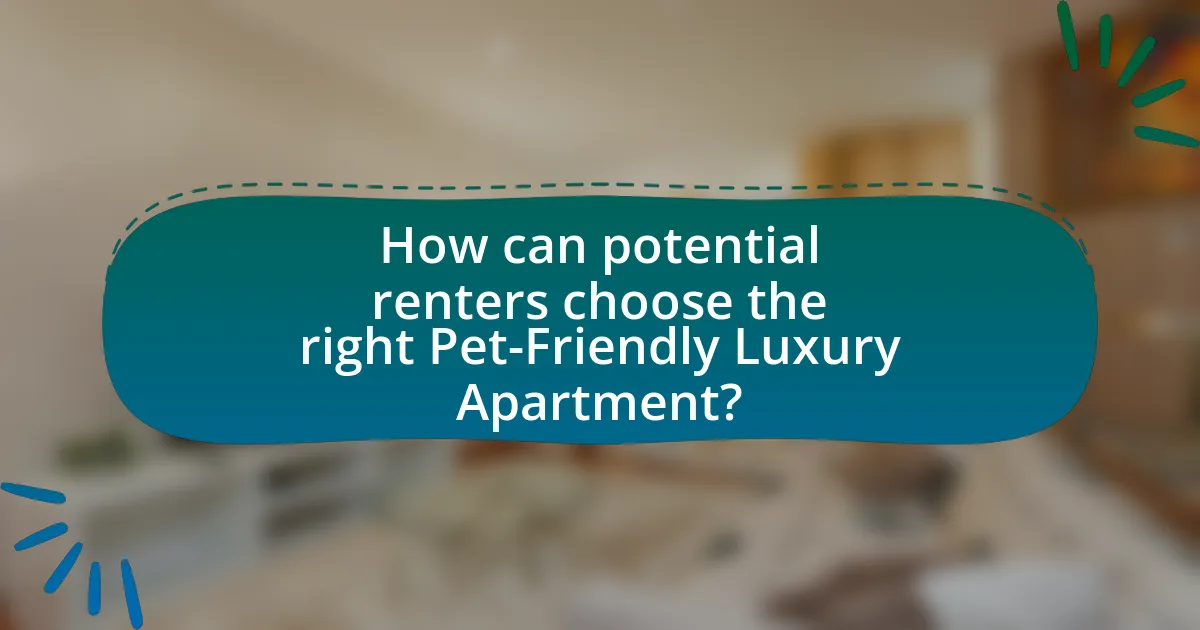Pet-friendly luxury apartments are high-end residential units designed to accommodate pets, featuring specialized amenities such as dog parks, grooming stations, and pet-sitting services. These apartments differ from traditional options by offering tailored services and policies that cater to the needs of both pets and their owners, reflecting the growing demand for such accommodations in the housing market. Key considerations for potential renters include evaluating pet policies, available amenities, and location, as well as understanding the specific features that enhance the living experience for pets. The article also addresses common challenges faced by pet owners in luxury apartments and provides solutions for managing pet behavior in shared living spaces.

What are Pet-Friendly Luxury Apartments?
Pet-friendly luxury apartments are high-end residential units that accommodate pets, offering amenities and features designed specifically for the comfort and well-being of both residents and their animals. These apartments typically include pet-friendly policies, such as no breed restrictions, and may provide on-site pet parks, grooming stations, and pet-sitting services. According to a survey by the American Pet Products Association, approximately 67% of U.S. households own a pet, highlighting the demand for such accommodations in the luxury housing market.
How do Pet-Friendly Luxury Apartments differ from traditional apartments?
Pet-Friendly Luxury Apartments differ from traditional apartments primarily by offering specialized amenities and services tailored for pets. These luxury apartments often include features such as dog parks, pet grooming stations, and pet-friendly flooring, which are not typically found in standard apartments. Additionally, pet-friendly luxury apartments may provide services like pet sitting, dog walking, and access to pet-friendly events, enhancing the living experience for both residents and their pets. This focus on accommodating pets reflects a growing trend in the real estate market, where approximately 70% of U.S. households own pets, indicating a significant demand for such amenities.
What specific features make an apartment pet-friendly?
An apartment is considered pet-friendly when it includes specific features that accommodate pets comfortably and safely. Key features include pet-friendly flooring, such as tile or laminate, which is easier to clean and resistant to scratches; designated pet areas, like dog parks or pet relief stations, that provide outdoor space for exercise; and pet policies that allow various types of pets without excessive restrictions. Additionally, apartments with soundproofing can minimize noise disturbances from pets, while proximity to parks and pet services enhances the living experience for pet owners. These features collectively ensure a welcoming environment for both pets and their owners.
Why is the luxury aspect important for pet owners?
The luxury aspect is important for pet owners because it enhances their living experience and reflects their lifestyle choices. Pet owners often seek high-quality amenities that cater to their pets’ needs, such as spacious areas for play, grooming facilities, and pet-friendly services. Research indicates that 70% of pet owners consider their pets when choosing a residence, emphasizing the demand for luxury accommodations that prioritize both comfort and convenience for pets. This trend is supported by the growing market for pet-friendly luxury apartments, which offer features like dog parks, pet spas, and in-unit pet care services, aligning with the desires of affluent pet owners who value both their pets’ well-being and their own living standards.
What types of pets are typically accommodated in these apartments?
Pet-friendly luxury apartments typically accommodate dogs and cats. These apartments often have specific policies that allow for various breeds and sizes of dogs, as well as multiple cat breeds, reflecting the common preferences of pet owners. Many luxury apartments also provide amenities such as dog parks, pet washing stations, and pet-friendly common areas, which further support the inclusion of these types of pets.
Are there size or breed restrictions for pets in luxury apartments?
Many luxury apartments impose size or breed restrictions for pets. These restrictions often stem from concerns about safety, noise, and property damage. For instance, some luxury buildings may only allow small dog breeds or impose weight limits, typically around 25 to 50 pounds. Additionally, certain breeds, often labeled as aggressive, may be prohibited entirely. These policies are designed to maintain a peaceful living environment and protect the property, reflecting common practices in the luxury rental market.
How do pet policies vary among different luxury apartment complexes?
Pet policies among different luxury apartment complexes vary significantly, with some allowing multiple pets while others impose strict limits. For instance, certain complexes may permit two pets with a combined weight limit of 100 pounds, while others might only allow one pet under 25 pounds. Additionally, some luxury apartments charge non-refundable pet fees and monthly pet rent, whereas others may not have such charges. These variations reflect the complexes’ target demographics and their commitment to creating a pet-friendly environment, as evidenced by amenities like dog parks and pet grooming stations that cater to residents with pets.
What amenities are commonly found in Pet-Friendly Luxury Apartments?
Pet-friendly luxury apartments commonly feature amenities such as dog parks, pet grooming stations, and pet-friendly walking paths. These amenities cater specifically to the needs of residents with pets, enhancing their living experience. Additionally, many of these apartments offer pet-sitting services, on-site pet care, and pet-friendly social events, which foster a community atmosphere for pet owners. The inclusion of these amenities reflects a growing trend in the real estate market, where approximately 70% of renters consider pet policies as a significant factor in their housing decisions.
What outdoor spaces are available for pets?
Outdoor spaces available for pets typically include dog parks, pet-friendly gardens, and designated pet areas within apartment complexes. Dog parks provide a secure environment for pets to socialize and exercise, often featuring agility equipment and separate areas for small and large dogs. Pet-friendly gardens allow pets to roam in a controlled setting, while designated pet areas in luxury apartments often include amenities like pet washing stations and seating for owners. These spaces cater specifically to the needs of pets, promoting their well-being and enhancing their living experience in pet-friendly luxury apartments.
How do indoor amenities cater to the needs of pets?
Indoor amenities cater to the needs of pets by providing designated spaces and features that enhance their comfort and well-being. For example, pet-friendly luxury apartments often include pet washing stations, which facilitate easy grooming and hygiene maintenance. Additionally, these apartments may offer indoor play areas equipped with toys and climbing structures, allowing pets to exercise and socialize safely. Furthermore, amenities such as pet-friendly flooring and soundproofing contribute to a more comfortable living environment for pets, reducing stress and potential damage from pet-related activities. These features are designed to meet the physical and emotional needs of pets, ensuring a harmonious living experience for both pets and their owners.
How do these amenities enhance the living experience for pet owners?
Pet-friendly amenities significantly enhance the living experience for pet owners by providing essential services and spaces that cater to their pets’ needs. These amenities, such as dog parks, pet washing stations, and pet-friendly walking trails, create a convenient and enjoyable environment for both pets and their owners. For instance, access to a dedicated dog park allows pets to socialize and exercise, which contributes to their overall well-being and reduces stress for owners who may otherwise need to travel to find such spaces. Additionally, features like pet washing stations simplify the grooming process, saving time and effort for pet owners. Overall, these amenities foster a community that values pet ownership, making it easier for owners to care for their pets while enjoying a higher quality of life.
What are the benefits of living in a Pet-Friendly Luxury Apartment?
Living in a pet-friendly luxury apartment offers several benefits, including enhanced quality of life for both pets and their owners. These apartments typically provide amenities such as pet parks, grooming stations, and pet-friendly social events, which foster a community atmosphere and promote socialization among residents and their pets. Additionally, studies indicate that pet ownership can reduce stress and improve mental health, making these living environments particularly appealing for pet owners seeking a supportive community. Furthermore, luxury apartments often feature spacious layouts and high-quality finishes that accommodate pets comfortably, ensuring a harmonious living experience.
How do these apartments promote a healthy lifestyle for pets?
These apartments promote a healthy lifestyle for pets by providing dedicated amenities such as dog parks, pet grooming stations, and walking trails. The presence of dog parks allows pets to socialize and exercise, which is essential for their physical and mental well-being. Additionally, on-site grooming stations facilitate regular hygiene maintenance, contributing to overall health. Walking trails encourage daily exercise, helping to prevent obesity and related health issues in pets. These features collectively create an environment that supports active and healthy lifestyles for four-legged residents.
What community features support pet owners in these apartments?
Community features that support pet owners in these apartments include designated pet parks, pet washing stations, and pet-friendly walking trails. These amenities provide safe spaces for pets to exercise and socialize, while washing stations facilitate easy grooming. Additionally, some apartments may offer pet care services or events, enhancing the overall living experience for pet owners.

What specific amenities cater to Four-Legged Residents?
Pet-friendly luxury apartments typically offer amenities such as dog parks, pet washing stations, and pet-friendly walking trails. These features are designed to enhance the living experience for residents with pets, ensuring they have spaces to exercise and socialize. For instance, dog parks provide a secure area for pets to play off-leash, while pet washing stations facilitate easy cleaning after outdoor activities. Additionally, walking trails encourage regular exercise for both pets and their owners, promoting a healthy lifestyle.
What types of pet services are offered in luxury apartments?
Luxury apartments typically offer a range of pet services including pet grooming, dog walking, pet sitting, and on-site pet parks. These services cater to the needs of pet owners, enhancing the living experience for both residents and their pets. Many luxury apartments also provide pet care packages, which may include training sessions and veterinary services, ensuring comprehensive support for pet owners. The inclusion of these services reflects a growing trend in the real estate market, where 68% of U.S. households own a pet, highlighting the demand for pet-friendly amenities in residential living spaces.
How do grooming and pet care services enhance convenience for residents?
Grooming and pet care services enhance convenience for residents by providing on-site access to essential pet maintenance, which saves time and effort. These services eliminate the need for residents to travel to external facilities, allowing them to manage their pets’ grooming needs within the comfort of their living environment. Additionally, having professional grooming services readily available ensures that pets receive timely care, which can contribute to their overall health and well-being. This convenience is particularly beneficial for busy residents who may struggle to find time for pet care amidst their daily responsibilities.
What role do pet-friendly events play in community building?
Pet-friendly events play a significant role in community building by fostering social interactions among residents and their pets. These events create opportunities for pet owners to connect, share experiences, and build relationships, which enhances the sense of belonging within the community. Research indicates that communities with active social engagement, such as pet-friendly gatherings, report higher levels of satisfaction and lower turnover rates among residents. For instance, a study by the American Pet Products Association found that 68% of U.S. households own a pet, highlighting the importance of catering to this demographic in community planning. By organizing pet-friendly events, communities not only attract pet owners but also promote inclusivity and collaboration, ultimately strengthening community ties.
How do luxury apartments ensure safety and comfort for pets?
Luxury apartments ensure safety and comfort for pets through a combination of secure environments, pet-friendly amenities, and specialized services. These apartments often feature secure entry systems, such as key fob access and surveillance cameras, which help prevent unauthorized access and protect pets from potential dangers. Additionally, many luxury apartments provide designated pet areas, such as dog parks or pet relief stations, which allow pets to exercise and socialize in a safe environment.
Furthermore, some luxury apartments offer services like pet grooming, walking, and even pet-sitting, ensuring that pets receive the care they need while their owners are busy. The incorporation of high-quality flooring and non-toxic materials also contributes to a pet-friendly atmosphere, minimizing risks associated with accidents or harmful substances. These features collectively create a safe and comfortable living space for pets, aligning with the growing demand for pet-friendly accommodations in luxury housing.
What security features are in place for pet owners?
Pet-friendly luxury apartments typically implement several security features for pet owners, including secure entry systems, surveillance cameras, and pet-specific amenities. Secure entry systems, such as key fob access or gated entrances, ensure that only residents and authorized guests can enter the premises, enhancing safety for both pets and their owners. Surveillance cameras monitor common areas, providing an additional layer of security and deterring potential incidents. Furthermore, some apartments may offer designated pet parks or play areas that are enclosed, allowing pets to roam safely while their owners supervise. These features collectively contribute to a secure living environment for pet owners and their animals.
How do apartment layouts accommodate pets’ needs?
Apartment layouts accommodate pets’ needs by incorporating designated spaces for pet activities, such as pet-friendly flooring, built-in pet areas, and easy access to outdoor spaces. These features ensure that pets have sufficient room to move and play, while also minimizing damage to the apartment. For example, many luxury apartments include features like dog parks, pet washing stations, and balconies designed for pet safety, which enhance the living experience for both pets and their owners. Additionally, the use of durable materials in flooring and furnishings helps to withstand wear and tear from pets, further supporting a pet-friendly environment.
What innovative technologies are integrated into Pet-Friendly Luxury Apartments?
Pet-friendly luxury apartments integrate innovative technologies such as smart pet doors, automated feeding systems, and pet monitoring cameras. Smart pet doors allow pets to enter and exit freely while ensuring security through app-controlled access. Automated feeding systems enable pet owners to schedule and control feeding times remotely, promoting regular feeding routines. Additionally, pet monitoring cameras provide real-time video feeds, allowing owners to check on their pets while away, enhancing safety and peace of mind. These technologies cater specifically to the needs of pet owners, making living spaces more convenient and enjoyable for both residents and their pets.
How do smart home features benefit pet owners?
Smart home features benefit pet owners by providing enhanced convenience, safety, and monitoring capabilities for their pets. For instance, smart cameras allow pet owners to observe their pets remotely, ensuring they are safe and not engaging in destructive behavior. Additionally, smart feeders can dispense food on a schedule, ensuring pets are fed even when owners are away. According to a survey by the American Pet Products Association, 67% of U.S. households own a pet, highlighting the growing need for technology that supports pet care. Furthermore, smart home systems can integrate with environmental controls to maintain optimal temperature and air quality for pets, contributing to their overall well-being.
What role does technology play in monitoring pet health and safety?
Technology plays a crucial role in monitoring pet health and safety by providing tools that enable real-time tracking and assessment of pets’ well-being. Devices such as smart collars and health monitoring apps allow pet owners to track vital signs, activity levels, and location, ensuring that pets remain safe and healthy. For instance, smart collars equipped with GPS can alert owners if a pet strays beyond a designated area, while health monitoring devices can detect changes in behavior or physical condition, prompting timely veterinary care. These technological advancements enhance the ability of pet owners to respond quickly to health issues, thereby improving overall pet safety and health outcomes.

How can potential renters choose the right Pet-Friendly Luxury Apartment?
Potential renters can choose the right pet-friendly luxury apartment by evaluating specific amenities and policies that cater to pets. Key factors include checking for on-site pet parks, pet grooming services, and pet-friendly flooring, which enhance the living experience for both pets and their owners. Additionally, reviewing the apartment’s pet policy, including breed restrictions and pet fees, is crucial to ensure compatibility with the renter’s pet. Research indicates that 67% of U.S. households own a pet, highlighting the demand for such accommodations and the importance of these features in attracting renters.
What factors should be considered when selecting a pet-friendly apartment?
When selecting a pet-friendly apartment, key factors include pet policies, available amenities, and location. Pet policies dictate the types of pets allowed, breed restrictions, and any associated fees or deposits, which can significantly impact the overall cost of living. Amenities such as dog parks, pet washing stations, and nearby walking trails enhance the living experience for both pets and their owners. Additionally, the apartment’s location should provide access to veterinary services, pet supply stores, and green spaces, ensuring convenience for pet care and recreation. These considerations collectively ensure a suitable environment for both residents and their pets.
How important is the location in relation to pet-friendly amenities?
Location is crucial in relation to pet-friendly amenities because it directly influences the availability and accessibility of services and spaces that cater to pets. For instance, proximity to parks, pet stores, and veterinary clinics enhances the quality of life for pet owners, making it easier to meet their pets’ needs. Research indicates that 70% of pet owners prioritize access to green spaces when choosing a residence, highlighting the significance of location in providing essential amenities for pets.
What questions should renters ask during apartment tours?
Renters should ask about pet policies, including breed restrictions and additional fees, during apartment tours. Understanding the specific pet policies is crucial, as many luxury apartments have unique regulations regarding pets. For example, some may charge a non-refundable pet deposit or monthly pet rent, while others may limit the size or breed of pets allowed. Additionally, renters should inquire about available pet amenities, such as dog parks, pet washing stations, and nearby walking trails, to ensure the apartment meets their and their pets’ needs.
What tips can help pet owners transition to a new luxury apartment?
To help pet owners transition to a new luxury apartment, it is essential to familiarize pets with the new environment gradually. This can be achieved by allowing pets to explore the apartment room by room, ensuring they feel comfortable in their new surroundings. Additionally, maintaining a consistent routine for feeding, walking, and playtime can ease the adjustment process. Research indicates that pets thrive on routine, which can reduce anxiety during transitions. Furthermore, utilizing pet-friendly amenities offered by luxury apartments, such as dog parks or pet grooming services, can enhance the settling-in experience. These amenities not only provide convenience but also promote socialization for pets, making the transition smoother.
How can pet owners prepare their pets for moving into a new environment?
Pet owners can prepare their pets for moving into a new environment by gradually acclimating them to the new space before the actual move. This can be achieved by allowing pets to explore the new apartment while it is still empty, familiarizing them with the layout and smells. Additionally, maintaining a consistent routine during the transition, such as feeding and walking schedules, helps reduce anxiety. Research indicates that pets thrive on routine, which can mitigate stress associated with relocation. Furthermore, providing familiar items, such as toys and bedding, can create a sense of security in the new environment.
What strategies can help pets adjust to apartment living?
To help pets adjust to apartment living, owners should implement gradual acclimatization, establish a routine, and provide ample exercise opportunities. Gradual acclimatization involves slowly introducing pets to the new environment, allowing them to explore different areas of the apartment at their own pace. Establishing a routine helps pets feel secure, as they thrive on predictability in feeding, walking, and playtime. Providing ample exercise opportunities, such as daily walks and interactive play sessions, is crucial for maintaining their physical and mental well-being in a confined space. Research indicates that regular exercise can reduce behavioral issues in pets, making it essential for their adjustment to apartment living.
What are the common challenges faced by pet owners in luxury apartments?
Pet owners in luxury apartments commonly face challenges such as limited space for pets to roam, restrictions on pet types and sizes, and inadequate outdoor areas for exercise. Limited square footage can restrict a pet’s movement and play, making it difficult for larger breeds to thrive. Many luxury apartments impose strict pet policies, often prohibiting certain breeds or requiring additional deposits, which can create barriers for potential pet owners. Additionally, the lack of accessible green spaces or designated pet areas can hinder regular exercise and socialization opportunities for pets, impacting their overall well-being.
How can pet owners address noise concerns in shared living spaces?
Pet owners can address noise concerns in shared living spaces by implementing soundproofing measures and training their pets to minimize noise. Soundproofing can include using rugs, curtains, and acoustic panels to absorb sound, which has been shown to reduce noise levels significantly in residential environments. Additionally, training pets to respond to commands and using positive reinforcement can help decrease excessive barking or other disruptive noises. Studies indicate that well-trained pets are less likely to create disturbances, thus fostering a more harmonious living situation in shared spaces.
What solutions exist for managing pet behavior in apartments?
Solutions for managing pet behavior in apartments include consistent training, providing adequate exercise, and creating a stimulating environment. Consistent training helps pets understand boundaries and reduces unwanted behaviors, while regular exercise, such as daily walks or playtime, alleviates pent-up energy that can lead to destructive actions. Additionally, enriching the living space with toys, scratching posts, and interactive activities keeps pets engaged and minimizes boredom-related issues. Studies show that well-exercised and mentally stimulated pets exhibit fewer behavioral problems, supporting the effectiveness of these solutions.


